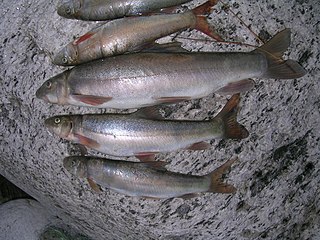Related Research Articles

The giant panda, also known as the panda bear or simply the panda, is a bear native to south central China. It is characterised by large, black patches around its eyes, over the ears, and across its round body. The name "giant panda" is sometimes used to distinguish it from the red panda, a neighboring musteloid. Though it belongs to the order Carnivora, the giant panda is a folivore, with bamboo shoots and leaves making up more than 99% of its diet. Giant pandas in the wild will occasionally eat other grasses, wild tubers, or even meat in the form of birds, rodents, or carrion. In captivity, they may receive honey, eggs, fish, yams, shrub leaves, oranges, or bananas along with specially prepared food.

Magnolia is a large genus of about 210 flowering plant species in the subfamily Magnolioideae of the family Magnoliaceae. It is named after French botanist Pierre Magnol.

Aspidistra is a genus of flowering plants in the family Asparagaceae, subfamily Nolinoideae, native to eastern and southeastern Asia, particularly China and Vietnam. They grow in shade under trees and shrubs. Their leaves arise more or less directly from ground level, where their flowers also appear. The number of species known has increased considerably from the 1980s onwards, with around 100 accepted as of July 2013. Aspidistra elatior is common worldwide as a foliage house plant that is very tolerant of neglect. It and other species can also be grown in shade outside, where they are generally hardy to −5 °C (23 °F).

The Polyporales are an order of about 1800 species of fungi in the division Basidiomycota. The order includes some polypores as well as many corticioid fungi and a few agarics. Many species within the order are saprotrophic, most of them wood-rotters. Some genera, such as Ganoderma and Fomes, contain species that attack living tissues and then continue to degrade the wood of their dead hosts. Those of economic importance include several important pathogens of forest and amenity trees and a few species that cause damage by rotting structural timber. Some of the Polyporales are commercially cultivated and marketed for use as food items or in traditional Chinese medicine.

Cymbidium, commonly known as boat orchids, is a genus of evergreen flowering plants in the orchid family Orchidaceae. Orchids in this genus are epiphytic, lithophytic, terrestrial or rarely leafless saprophytic herbs usually with pseudobulbs. There are usually between three and twelve leaves arranged in two ranks on each pseudobulb or shoot and lasting for several years. From one to a large number of flowers are arranged on an unbranched flowering stem arising from the base of the pseudobulb. The sepals and petals are all free from and similar to each other. The labellum is significantly different from the other petals and the sepals and has three lobes. There are about fifty-five species and sixteen further natural hybrids occurring in the wild from tropical and subtropical Asia to Australia. Cymbidiums are well known in horticulture and many cultivars have been developed.

Paul Ching Wu Chu is a Chinese-American physicist specializing in superconductivity, magnetism, and dielectrics. He is a Professor of physics and T.L.L. Temple Chair of Science in the Physics Department at the University of Houston College of Natural Sciences and Mathematics. He was the President of the Hong Kong University of Science and Technology from 2001 to 2009. In 1987, he was one of the first scientists to demonstrate high-temperature superconductivity.
This list contains species first discovered in Hong Kong, with the endemic species asterisked.
Ulmus gausseniiW. C. Cheng, the Anhui, or hairy, elm, is a medium size deciduous tree whose natural range is restricted to the valleys of the Langya limestone mountains of Chu Xian in Anhui Province, eastern China. The tree was most commonly found on the flood plains, indicating a tolerance of periodic inundation. However, U. gaussenii is now possibly the rarest and most endangered elm species, with only approximately 30 trees known to survive in the wild in 2009. The tree was introduced to the West in 1995, at the Morton Arboretum, Illinois, as part of an evaluation of Chinese elms for landscape use.

Schizothorax is a genus of cyprinid fish found in southern and western China, through northern South Asia (Himalaya) and Central Asia, to Iran, with a single species, S. prophylax, in Turkey. They are primarily found in highland rivers, streams and lakes, although a few species occur in lower-lying locations, like Lake Balkhash and lakes of the Sistan Basin. Their scientific name means "cloven-breast", from Ancient Greek schízeïn (σχίζειν) "to cleave" and thórax (θώραξ) "breast-plate". The western species are typically referred to as marinkas from their Russian name marinka (маринка), while the eastern species are usually called snowtrout. Although they do resemble trouts in habitus this is merely due to convergent evolution and they are by no means closely related apart from both being Teleostei: Cyprinids are in the teleost superorder Ostariophysi, while trouts are in the superorder Protacanthopterygii. Their ancestors must thus have diverged as early as the Triassic, more than 200 million years ago.
Sinocyclocheilus is a genus of freshwater fish in the family Cyprinidae endemic to China, where only found in Guangxi, Guizhou and Yunnan. Almost all of its species live in or around caves and most of these have adaptions typical of cavefish such as a lack of scales, lack of pigmentation and reduced eyes. Several species have an unusual hunchbacked appearance and some of the cave-dwellers have a "horn" on the back, the function of which is unclear. In contrast, the Sinocyclocheilus species that live aboveground, as well as a few found underground, show no clear cavefish adaptions. They are relatively small fish reaching up to 23 cm (9.1 in) in length. The individual species have small ranges and populations, leading to the status of most of the evaluated species as threatened. Many species populations in the genus have yet to be evaluated by the IUCN.

Oreonectes is a genus of fish in the family Nemacheilidae found in the rivers and cave of Asia. Many of these species are troglobitic.

Triplophysa is a genus of fish in the family Nemacheilidae found mainly in and around the Qinghai-Tibet Plateau in China. Currently, the genus is a mixed assemblage of species. Some lineages have been identified and treated as subgenera, but as Wikipedia follows Fishbase for fish species these have been treated as subgenera in Wikipedia, although Kottelat and the Catalog of Fishes treat them as genera. FishBase, however, includes these in Triplophysa without specifying subgenera and treats the names given by Kottelat as synonyms.

Yunnanilus is a genus of small stone loaches that are endemic to southeastern China, especially Guangxi and Yunnan. They are found in rivers, streams and lakes; some species are restricted to caves.

Paracymoriza is a genus of moths of the family Crambidae.
Megasporoporia is a genus of four species of crust fungi in the family Polyporaceae. The genus is characterized by its large spores, and dextrinoid skeletal hyphae.

Mesobuthus martensii is a species of scorpion in the family Buthidae. Its common names include Chinese scorpion, Manchurian scorpion, Chinese armor-tail scorpion and Chinese golden scorpion. Despite its common name, this scorpion is not only found in Manchuria or China, but also in Mongolia and Japan. Its preferred habitat is warm, dry areas with little vegetation. M. martensii can grow to about 6 centimetres (2.4 in) long, with females usually slightly larger, and has a life-span of about 4 to 6 years.
Anabasis is a genus of snout moths. It was described by Carl Heinrich in 1956. The genus was long thought to contain only one species, the cassia webworm.
Pseudanabasis is a genus of snout moth. It was described by Y.L. Du, S.M. Song and C.S. Wu in 2009. The genus contains only one species, Pseudanabasis incanimaculata, which is found in China (Xizang).
Troglonectes is a genus of troglobitic fish in the family Nemacheilidae, native to caves of Asia. Fishbase and other authorities place these species in the genus Oreonectes.
References
- ↑ Du, Y.-L. ; S.-M. Song & C.-S. Wu, 2009: A new species of Anabasis Heinrich and a related new genus from China (Lepidoptera: Pyralidae: Phycitinae). Transactions of the American Entomological Society135 (3): 369-375. doi : 10.3157/061.135.0303
| | This Phycitinae-related article is a stub. You can help Wikipedia by expanding it. |